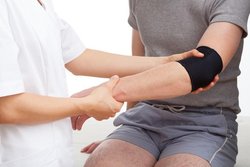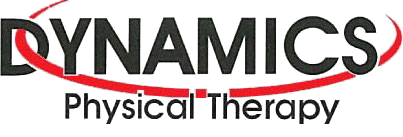Managing Tennis Elbow
Did you know that although Tennis Elbow has been named due to its common affliction of tennis players, anyone can experience pain due to injury of the muscles and tendons near the elbow?
Persistent pain is your body’s way of indicating that something is wrong, so you shouldn’t ignore it!
If you’re experiencing acute or chronic pain with loss of function, the physical therapists at Dynamics Physical Therapy may be able to help you reduce and better manage your discomfort and get you back to doing what you love.
The Basics of Tennis Elbow
Tennis elbow refers to a condition in which muscles or tendons in the forearm become overworked or injured and cause pain in the elbow. Tennis elbow specifically causes pain that starts on the outside bump of the elbow, the lateral epicondyle. The forearm muscles that bend the wrist back (the extensors) attach on the lateral epicondyle and are connected by a single tendon. Tendons connect muscles to bone.
The medical term for tennis elbow is lateral epicondylitis if there is acute inflammation, or more commonly, lateral epicondylosis whereby wear and tear is thought to lead to tissue degeneration in the absence of inflammation.
| Tennis players most commonly suffer from this type of injury due to the repetitive forceful movements of the wrist and elbow while gripping a racquet, but anyone who engages in activities that require repeated movements of the arms, elbows, or wrists may experience tennis elbow. Baseball players, golfers, bowlers, professional cleaners, factory workers, mechanics, and gardeners are other examples of people who often struggle with this condition. |  |
Tennis elbow typically affects a person’s dominant arm, but may develop in either arm. It also tends to affect men more often than women.
Symptoms of tennis elbow include:
- Pain or burning in the elbow that slowly intensifies
- Pain that worsens when an object is squeezed or lifted
- A weak grip or intense pain in the elbow while gripping objects
- Pain that gets worse when the wrist is moved (e.g., opening jars, brushing the teeth)
Pain Management Strategies
Having a comprehensive assessment by the physical therapists at Dynamics Physical Therapy can be of tremendous value in helping you understand the role that your daily routine and activities may be playing in regard to your tennis elbow. They can complete a detailed biomechanical and postural exam, and help you develop healthy motor patterns again by designing a specific program to restore the function and mobility of your elbow.
To start, it is important to give the elbow some relative rest for a while by discontinuing any activities that worsen the symptoms. This may even mean resting the elbow for several weeks.
Strength exercises and stretching techniques, which are best guided by a physical therapist, help the injured muscles or tendons heal and tolerate normal loads again. This strategy is also useful for restoring the mobility of the elbow.
Physical therapy, in particular, may involve a combination of methods such as muscle-stimulation techniques, massage, manual therapy, and exercise. It may also be recommended that you try wearing a brace, which provides extra support and load sharing for the muscles and tendons that need time to heal.
In the majority of cases, individuals fully recover without having to receive invasive treatment.
Simple Self-Care Exercises to Avoid Tennis Elbow
Here are some examples of exercises that the physical therapists at Dynamics Physical Therapy may suggest to help prevent or improve tennis elbow.
Be sure to contact a physical therapist or doctor before undertaking any exercise activities to ensure appropriate activities for your condition or level of activity.
Eccentric wrist extension exercise – this is a type of exercise wherein the muscle is lengthening against a load, and has been shown to increase muscle strength and reduces pain in tendinopathy. It involves using a light dumbbell, water bottle, or can of food, sitting in a chair that has an armrest, and resting the forearm on the armrest while holding the weight with the palm faced down. Lift the wrist up and then slowly return it to the resting position. Try this exercise 3 to 4 times per week, 3 sets of 10 reps (or to forearm fatigue), for at least 6 weeks. These must be done pain free.
Eccentric Wrist Flexor Exercise – Similarly, this exercise involves holding a dumbbell or a can of food, sitting in a chair and placing the forearm flat on the thigh with the hand holding the weight facing upward. Let the wrist bend backward slowly and then bend the wrist upward again. Repeat this movement 10 times and perform it 3 times, every other day for at least 6 weeks.
Forearm Flexor and Extensor Stretches – These stretches improve blood flow to the injured region, which boosts healing. They entail holding out the affected arm, parallel to the floor and bending the wrist up or down with the elbow straight and applying a gentle pull to the bent wrist and hand to stretch the forearm. Hold these stretches for 30 seconds, and repeat them 2-3 times per day, particularly if you work at a computer or are very active in sport.
Tricep Stretch – This stretch helps improve recovery by decreasing mobility problems and stiffness that may develop while resting the elbow. It entails bending the arm backward, behind the back, while mimicking scratching the back. Use the unaffected arm to gently press the elbow backward until non-painful stretching is felt. Hold this stretch for 30 seconds and perform it 3 times, every other day.
The physical therapists at Dynamics Physical Therapy can assess your condition and develop a treatment plan that will set you on the right track toward a speedy recovery. Give Dynamics Physical Therapy a call today to get started.
For more detailed information click here refer to our patient guide.
References
- Weber C, Thai V, Neuheuser K, Groover K, Christ O. Efficacy of physical therapy for the treatment of lateral epicondylitis: a meta-analysis. BMC Musculoskelet Disord. 2015 Aug 25;16(1):223.
- Shiri R, Viikari-Juntura E, Varonen H, Heliövaara M. Prevalence and determinants of lateral and medial epicondylitis: a population study. Am J Epidemiol. 2006 Dec 1; 164(11):1065-74.
- Gündüz R, Malas FÜ, Borman P, Kocaoğlu S, Özçakar L. Physical therapy, corticosteroid injection, and extracorporeal shock wave treatment in lateral epicondylitis. Clinical and ultrasonographical comparison. Clin Rheumatol. 2012 May;31(5):807-12.
- Peterson M, Butler S, Eriksson M, Svärdsudd K. A randomized controlled trial of eccentric vs. concentric graded exercise in chronic tennis elbow (lateral elbow tendinopathy). Clin Rehabil. 2014 Sep;28(9):862-72.
- Ng GY, Chan HL. The immediate effects of tension of counterforce forearm brace on neuromuscular performance of wrist extensor muscles in subjects with lateral humeral epicondylosis. J Orthop Sports Phys Ther. 2004 Feb;34(2):72-8.
- Croisier JL, Foidart-Dessalle M, Tinant F, Crielaard JM, Forthomme B. An isokinetic eccentric programme for the management of chronic lateral epicondylar tendinopathy. Br J Sports Med. 2007 Apr;41(4):269-75.


